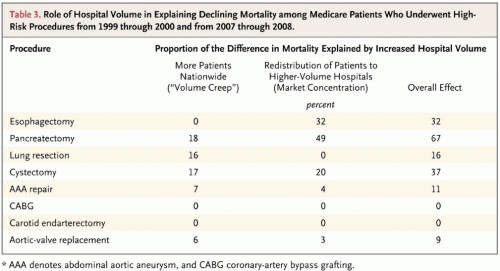A new paper by Finks, Osborne and Biermeyer (ungated) in the latest NEJM provides new insight into the relationship between volume (number of procedures) and surgical mortality (outcome). An inverse relationship has been identified for some procedures, that suggests a ‘practice makes perfect’ situation. There has been a great deal of effort the past decade to create and disseminate minimum volume standards for surgical procedures demonstrating this relationship, in an attempt to encourage regionalization (patients traveling to a high volume center for have surgery instead of getting it in their hometown), and improve patient outcomes. These efforts have mostly been driven by surgical specialty groups, and private insurance companies.
There are barriers to regionalization, including patient preference for local care, financial incentives of local providers, and lack of access in some geographical areas to a referral center. This study looked at trends in common cancer and cardiovascular surgeries among Medicare beneficiaries from 1999 to 2008 that have been linked to a volume/outcome relationship in the past and identified as candidates for regionalization. The study identified changes in median hospital volume, associated this with changes in outcomes, and determined whether reductions in mortality over the period could be attributed to regionalization of care versus increased volume attributable to more patients nationally receiving a procedure.
The median hospital volume of the four cancer surgeries assessed, AAA repair and Aortic valve replacement increased nationally, while the median hospital volume for CABG and Carotid Endarterectomy declined. Hospital volume increases for esphoagectomy were due totally to market concentration or regionalization, as the total number of procedures nationally was unchanged, but fewer hospitals performed the procedure. The reason for increasing volume of Aortic valve replacement was the opposite, as it was driven totally by an increasing number of overall procedures done. Hospital volume increased for the other 4 procedures due to a mix of these two factors (and declined for CABG & Carotid End.).
Risk adjusted mortality rates improved from 1999 to 2008 for all 8 of the procedures considered (p<0.001), but the degree to which increasing volume contributed to this decline differed a great deal. Pancreatectomy showed the largest mortality improvement that was associated with increased surgical volume: two-thirds of the improvement was due to increasing hospital volume. Around half of the total improvement attributable to increased volume was due to regionalization of care, and the other one fifth was due to an overall increase in the volume of the procedure, nationally. For esophagectomy, all of the mortality decrease observed that was due to increased hospital volume was attributable to regionalization (32%), while for lung cancer resection none of the gains were due to regionalization, but occurred all of the gains (16%) were due to an increase in total procedures performed.
Carotid Endarterectomy and CABG mortality improved over the same period, but surgical volume dropped nationally as the overall number of cases fell while the number of facilities providing the procedure rose.
Several points to emphasize:
- All of the procedures considered were identified as candidates for regionalization due to the existence of a volume/outcome relationship in past work
- The volume/outcome relationship for mortality improvements since 1999 was found to be stronger for some procedures assessed than others
- Regionalization lead to improved outcomes over the past decade for some procedures, but not others
- Regionalization is a more important explanation for improvements in rarer surgeries, where the financial penalty for local hospitals is reduced
- Outcome improvements occurred even with declining volume among procedures earlier said to display a volume/outcome relationship.
- There were many things other than volume changes taking place to improve outcomes during this study; mortality improvements appear to be real, and not simply artifacts attributable to case mix (patients being otherwise healthier)
- The study population was Medicare patients, and the Medicare program does nothing to control or even advise patients regarding where they can/should seek care. Regionalization trends were therefore not due to Medicare policy
- Public and private payers are likely to become increasingly interested in the volume/regionalization issue as they seek improved outcomes for the care they purchase
Update 1: Austin reminds me that he posted on this recently, focusing on endogeneity of volume/outcome. This means that while volume could influence outcome, outcome also can influence volume. The paper reviewed here does not address/attempt to deal with this issue. I need to think a bit about how this influences interpretation of this study, esp whether endogeneity may be more of an issue for some procedures than others. Key issue is how rare is the surgery, I think. Thoughts?


